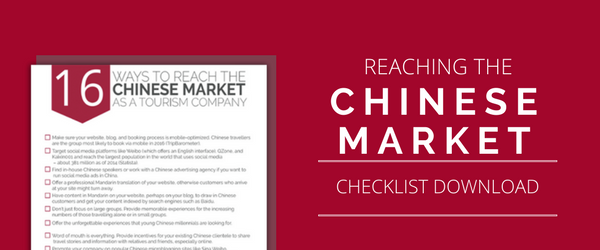We've published a newer article focusing on the Chinese market and how the market will develop in 2017. Head over here to read it.
The Chinese market for tour and activity companies is huge, and happens to be the fastest growing tourism source in the last decade. However, it’s often difficult for tour operators to successfully tap into this market.
Here is what you need to know about the Chinese tourism market in order to get more bookings for your tour or activity company.

The advantages of targeting the Chinese market
If you’re a tour operator or activity provider, China offers a serious growth opportunity. According to the FT, Chinese travelers spent a whopping $498 billion in 2014 on outbound travel, underlining why this massive market is so important.
Chinese travelers are now frequently branching out of Asia as well. For example, over 2 million Chinese travelers arrived in the U.S. last year, and spent an average of $6,000 per person.
The importance of mobile
China is a country that loves mobile. In fact, it's the biggest smartphone market on the planet. Those tour operators that target their ads towards Chinese mobile users will have a definite advantage. PricewaterhouseCooper (PwC) indicated that there are 466 million smartphone users as of 2014.
These smartphone users are not only making many of their purchases through their smartphone, but are mining their smartphones for information. PwC found that 98 percent of Chinese respondents use their smartphone to initiate the shopping process, even if they don’t use their phone to make an actual purchase.

Marketing to China across social media
Many travel operators greatly rely on social media to find and appeal to their customers. However, in China, there is no access to YouTube, Facebook or Twitter, but that doesn’t mean the Chinese aren’t using social media. In fact, China has the largest population in the world that uses social media – about 381 million as of 2014.
That’s why, when considering your business plan, it’s important to target social media platforms like Weibo, QZone, and Kaixin001. Weibo is the largest social network in China, and has over 600 million registered users as of 2014. WeChat is also a huge part of Chinese society. This mobile app allows hundreds of millions of users to text, chat and share videos.
At the same time, there are some challenges to advertising with these social media platforms. Weibo offers the only truly English interface for advertising to the Chinese market. That means that if you want to run ads in China, you’ll either need in-house Chinese speakers or will have to work with an advertising agency in China. However, the investment for many traveler operators is well worth it.

How to appeal to the Chinese market
While in the past, most Chinese tourists traveled in large groups and built much of their trip around shopping, that is changing. Many Chinese travelers are either in small groups or alone, and many young millennials are looking for experiences.
This is why it’s also worthwhile to geo-target Chinese who live in high-income cities like Shanghai and Beijing. At the same time, your website should offer a professional Mandarin translation, otherwise customers who arrive at your site might turn away. You should also remember that popular Chinese search engines like Baidu don't index English characters. If you want to rank well when Chinese tourists perform searches, you need to have content in Mandarin, such as your blog, to draw in Chinese customers.
Word of mouth is very important for the Chinese market. If you already have a small clientele of Chinese customers, it’s important to provide them with incentives to share travel stories and information with their relatives and friends. You can also think about promoting your travel company on Chinese microblogging sites like Sina Weibo. These sites are extremely popular and allow users to recommend companies, experiences and products to each other.

The Chinese market also values big brand names and prestige, which might mean offering spa packages and excellent golf opportunities. You can even tie-in some luxury shopping options, as shopping often still appeals to Chinese tourists. Here are 5 ways to adapt your tours for a luxurious traveller.
Having a online booking system on your website also plays a part in building your travel agency into a “big brand name” for your Chinese customers. Chinese tourists value a smooth and reliable booking system when they’re purchasing a tour or vacation, and software like TrekkSoft is ideal for managing large groups while avoiding overbooking.
Ultimately, it's important to implement plenty of different strategies for reaching Chinese tourists.
So to reach the Chinese tourism market, make an effort to:
- Provide memorable experiences for those travelling alone or in small groups
- Geo-target those who live in high-income cities like Shanghai and Beijing
- Have your website translated into Mandarin
- Create content in Mandarin, such as on your blog, so you can appear in Baidu searches
- Think of incentives to promote word of mouth advertising from existing customers
- Remember that this market values big brand names
- Integrate an online booking system with your website to be perceived as a big brand
For more practical advice and insights into the Chinese market, check out this interview with Simon Bosshart, the Director of Asia Pacific and Global Accounts for Switzerland Tourism.
Read our latest article about the Chinese market here.
Gain 16 actionable tips to reach the Chinese market with your free checklist




